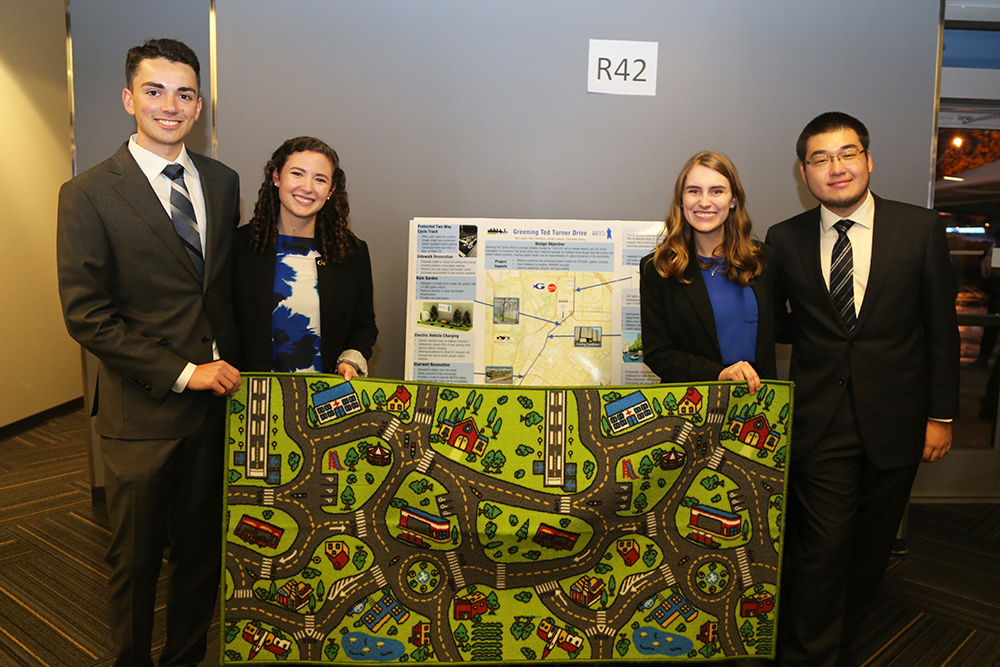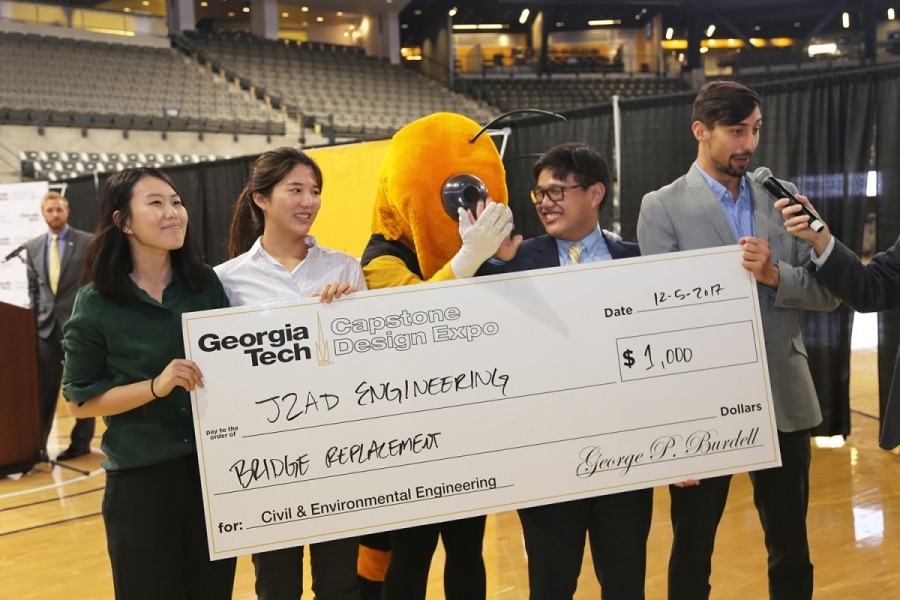 Team J2AD Engineering won the civil and environmental engineering award at the fall 2017 Capstone Design Expo. From left, Jessie Lei, Jiyoon Oh, Austin Foo and Donald Smith accept their winnings from Buzz (yellow jacket, center). (Photo: Jess Hunt-Ralston) |
The winning civil and environmental engineering project at the fall 2017 Capstone Design Expo doesn’t sound especially groundbreaking on paper. But in reality, it’s the kind of work that demonstrates the power engineers have to shape — and in this case, protect — communities.
Team J2AD Engineering had to design a replacement for a century-old bridge in the middle of historic Americus, Georgia. Hemmed in by a church on the National Register of Historic Places and Victorian-style homes, the four seniors had to figure out how to meet modern design and capacity standards while satisfying the Georgia Department of Transportation, the city of Americus, and the railroad that still uses the busy corridor.
“How do you make three stakeholders happy? You don’t,” said Donald Smith. “You just try to minimize the damage.”
Austin Foo, Jessie Lei, Jiyoon Oh and Smith considered four alternatives and settled on the one that made just enough room under the bridge to allow the railroad to run a train with double-stacked freight cars underneath but that didn’t disturb the neighborhood.
“You can’t just break up a community,” Foo said. “That’s part of civil engineering.”
Lei jumped in: “You have to design for humans.”
The team was one of 15 from the School of Civil and Environmental Engineering to present their senior design projects at the massive expo this fall. It’s the first time every senior design project in the School was required to prepare an exhibit at the event. As the judges’ top choice, the team wins $1,000.
 Team Artio LLC — from left, Jordan Dobson, Alexandra Logan, Mary McIntyre and Zhongduo "Frank" Zhang — with the road play mat they used to attract people at the Capstone Design Expo Dec. 5. They developed a dozen different ways to reinvigorate Ted Turner Drive in downtown Atlanta, from protected cycle tracks to innovative new technologies like solar crosswalks. (Photo: Jess Hunt-Ralston) |
Other teams designed a parachute-drying building for the Air National Guard base at the Savannah-Hilton Head International Airport; created a new bike connection to campus from 8th Street and Northside Drive; and created site plans for all kinds of projects.
One team worked with students from the Woodruff School of Mechanical Engineering to create 3-D printed concrete with steel-fiber reinforcement.
"The fiber alignment will alter the behavior and the strength of the printed specimen, so, in the end, we found a relatively workable mix to extrude concrete with fiber in it, and we also controlled the fiber alignment along the way," said Zonglin "Jack" Li, one of the students on the team.
Another team of four environmental engineering students tackled a road project — a little out of their wheelhouse, they admitted. But that’s what made it interesting, according to Alexandra Logan.
“We came up with 12 different ways to reinvigorate Ted Turner Drive [in downtown Atlanta],” Logan said. “It’s 1.4 miles, and we essentially went through and said, how can we make this better? How can we draw people to this area? How can we make it more sustainable, more resilient? We did transportation, we did energy, and then we also looked at how we can create more green spaces.”
Their dozen suggestions included everything from a protected cycle track and sidewalk renovations to new technologies like a solar crosswalk and a living wall of greenery.
As Logan’s teammate Jordan Dobson put it: “It’s all about making cities a better place to live.”

